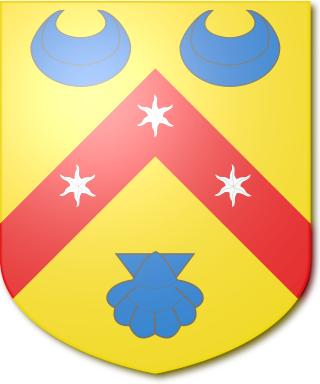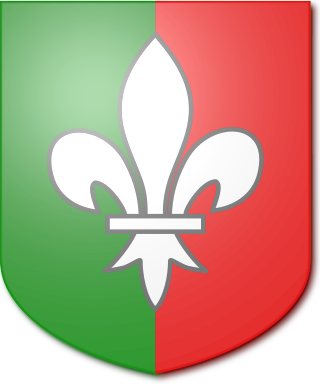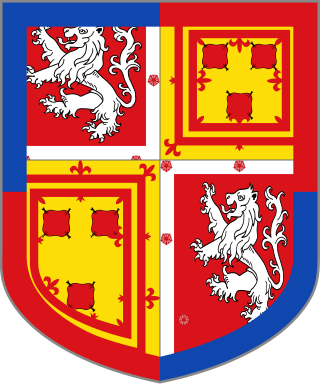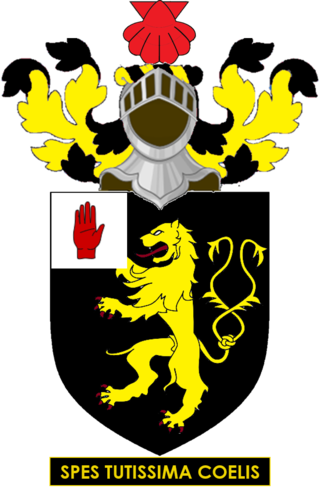
The Scott baronetcy, of Lytchet Minster in the County of Dorset, was created in the Baronetage of the United Kingdom on 8 September 1821 for Claude Scott. [1] The title became extinct on the death of the seventh Baronet in 1961. [2]

The Scott baronetcy, of Lytchet Minster in the County of Dorset, was created in the Baronetage of the United Kingdom on 8 September 1821 for Claude Scott. [1] The title became extinct on the death of the seventh Baronet in 1961. [2]
The Duffbaronetcy, of Halkin in the County of Aberdeen, is a title in the Baronetage of the United Kingdom. It was created on 12 November 1813 for James Duff, British Consul in Cádiz, with remainder to his nephew, William Gordon.

The Henniker Baronetcy, of Newton Hall in the County of Essex, was created in the Baronetage of the United Kingdom on 2 November 1813 for Brydges Henniker, who had earlier represented Kildare Borough in the last Irish Parliament. He was the youngest son of John Henniker, 1st Baron Henniker. The sixth baronet was an admiral in the Royal Navy and sat as Conservative member of parliament for Galloway. The eighth Baronet was a brigadier in the Royal Engineers.

The Medlycott Baronetcy, of Ven House in the County of Somerset, was a title in the Baronetage of the United Kingdom. It was created on 3 October 1808 for William Medlycott, Member of Parliament for Milborne Port from 1790 to 1791. The family descended from James Medlycott, of Ven House, who represented Milborne Port in the House of Commons between 1710 and 1722. His son Thomas Medlycott died without surviving male issue in 1763 and left his estates to his maternal nephew Thomas Hutchings, who adopted the surname of Medlycott. His son was the first Baronet. The baronetcy became extinct with the death of the 9th Baronet in 2021.

The Leeds Baronetcy, of Croxton Park in the County of Cambridge, is a title in the Baronetage of the United Kingdom. It was created on 31 December 1812 for George Leeds. He was an equerry to Prince Augustus Frederick, Duke of Sussex. The Croxton Park estate in Cambridgeshire had been in the Leeds family since circa 1568. As of 2011 the presumed ninth and present Baronet, a resident of Canada, has not successfully proven his succession and is not on the Official Roll of the Baronetage.

The Welby Baronetcy, of Denton Manor in the County of Lincoln, is a title in the Baronetage of the United Kingdom.

The Wedderburn, later Ogilvy-Wedderburn Baronetcy, of Balindean in the County of Perth, is a title in the Baronetage of the United Kingdom created in 1803.
The Floyd Baronetcy is a title in the Baronetage of the United Kingdom. It was created on 30 March 1816 for General John Floyd. He was second-in-command at the Battle of Seringapatam in 1799. Floyd's daughter Julia was the wife of Prime Minister Sir Robert Peel, 2nd Baronet. The fifth Baronet was a Brigadier in the 15th/19th Hussars and was Chief-of-Staff of the Eighth Army from 1944 to 1945. Between 1961 and 1968 he served as Lord-Lieutenant of Buckinghamshire. The seventh Baronet was High Sheriff of Rutland in 1968. The fourth baronet's youngest son, Charles Murray Floyd, was a prominent businessman, surveyor and land agent.

The ffolkes Baronetcy, of Hillington in the County of Norfolk, is a title in the Baronetage of Great Britain. It was created on 26 May 1774 for Martin ffolkes, FRS later High Sheriff of Norfolk and Member of Parliament for King's Lynn. The second Baronet represented Norfolk and Norfolk West in the House of Commons while the third Baronet represented King's Lynn. The fifth Baronet was Honorary Chaplain to Queen Victoria, Chaplain-in-Ordinary to Edward VII and George V and Chaplain to Edward VIII and George VI.

The Loraine Baronetcy, of Kirk Harle in the County of Northumberland, was a title in the Baronetage of England. It was created on 26 September 1664 for Thomas Loraine, High Sheriff of Northumberland. The second Baronet was Member of Parliament for Northumberland. The third Baronet was High Sheriff of Northumberland in 1742, the fourth Baronet in 1774 and the fifth Baronet in 1814. The eleventh Baronet was a rear admiral in the Royal Navy. The twelfth baronet was a distinguished diplomat. The title became extinct on his death in 1961.
The Jervoise, later Clarke-Jervoise Baronetcy, of Idsworth in the County of Southampton, was a title in the Baronetage of the United Kingdom. It was created on 13 November 1813 for Rev. Samuel Jervoise, born Samuel Clarke, who assumed the surname of Jervoise by royal licence in 1808.

The Pocock Baronetcy, of Hart in the County Palatine of Durham and of Twickenham in the County of Middlesex, was a title in the Baronetage of the United Kingdom. It was created on 18 August 1821 for George Pocock, Member of Parliament for Bridgwater. He was the son of Admiral Sir George Pocock. The title became extinct on the death of the 4th Baronet in 1921.

The Denys, later Denys-Burton, later Denys Baronetcy, of Stratford Place in the County of Middlesex, was a title in the Baronetage of the United Kingdom. It was created on 23 November 1813 for George Denys, Member of Parliament for Kingston upon Hull. The second Baronet was a Deputy Lieutenant for the North Riding of Yorkshire. The third Baronet assumed the additional surname of Burton. The fourth Baronet used the surname Denys only. The title became extinct on his death in 1960.

The Shelley baronetcy, of Michelgrove in the County of Sussex, was created in the Baronetage of England on 22 May 1611 for John Shelley.

The Cholmeley baronetcy, of Easton in the County of Lincoln, was created in the Baronetage of the United Kingdom on 4 March 1806 for Montague Cholmeley, subsequently Member of Parliament for Grantham. His son, the second Baronet, sat as Member of Parliament for North Lincolnshire. He was succeeded by his son, the third Baronet, who also represented Grantham as MP. His grandson, the fifth Baronet, was High Sheriff of Lincolnshire in 1961 and a Vice-Lord-Lieutenant and Deputy Lieutenant of the county.
The Morris baronetcy, of Clasemont in the County of Glamorgan, was created in the Baronetage of the United Kingdom on 12 May 1806 for the copper and coal magnate, John Morris. The 1st baronet had founded Morriston, the industrial suburb of Swansea, which was overlooked by the family seat at Clasemont. This residence was later knocked down and the stones were incorporated into a new family house at Sketty Park. Various lines died out, and the baronetcy eventually came to the 8th baronet, George Lockwood Morris, who succeeded at the age of 88, three months before his death. The 8th baronet had been a local industrialist and a Welsh international rugby player. The ninth baronet, the 8th baronet's son, was the painter and horticulturalist Cedric Morris.

The Shaw baronetcy, of Bushy Park in the County of Dublin, was created in the Baronetage of the United Kingdom on 17 August 1821 for the Tory politician Robert Shaw. The 3rd Baronet was also a politician.

The Dunbar baronetcy of Northfield was created for William Dunbar of Hempriggs House, Caithness, on 10 April 1700. He had served as a Member of the Scottish Parliament for Caithness constituency.

The Waller baronetcy, of Newport in the County of Tipperary, was created in the Baronetage of Ireland on 1 June 1780 for Robert Waller, Member of the Irish Parliament for Dundalk and a Commissioner of Revenue. The 2nd Baronet served as High Sheriff of King's County in 1826.

The King baronetcy, of Charlestown in the County of Roscommon, was created in the Baronetage of the United Kingdom on 1 July 1815 for Gilbert King, son of Gilbert King (1710–1788), Member of the Irish Parliament for Jamestown, and a direct descendant of Edward King, Bishop of Elphin.

The Paul baronetcy of Paulville in the County of Carlow was created in the Baronetage of Ireland on 20 January 1794 for Joshua Paul. He was the son of Christmas Paul, Member of the Parliament of Ireland for Waterford City. The title became extinct on the death of the 6th Baronet in 1961.